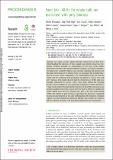Food talk : 40-Hz fin whale calls are associated with prey biomass
Abstract
Animals use varied acoustic signals that play critical roles in their lives. Understanding the function of these signals may inform about key life-history processes relevant for conservation. In the case of fin whales (Balaenoptera physalus), that produce different call types associated with different behaviours, several hypotheses have emerged regarding call function, but the topic still remains in its infancy. Here, we investigate the potential function of two fin whale vocalizations, the song-forming 20-Hz call and the 40-Hz call, by examining their production in relation to season, year and prey biomass. Our results showed that the production of 20-Hz calls was strongly influenced by season, with a clear peak during the breeding months, and secondarily by year, likely due to changes in whale abundance. These results support the reproductive function of the 20-Hz song used as an acoustic display. Conversely, season and year had no effect on variation in 40-Hz calling rates, but prey biomass did. This is the first study linking 40-Hz call activity to prey biomass, supporting the previously suggested food-associated function of this call. Understanding the functions of animal signals can help identifying functional habitats and predict the negative effects of human activities with important implications for conservation.
Citation
Romagosa , M , Pérez-Jorge , S , Cascão , I , Mouriño , H , Lehodey , P , Pereira , A , Marques , T A , Matias , L & Silva , M A 2021 , ' Food talk : 40-Hz fin whale calls are associated with prey biomass ' , Proceedings. Biological sciences , vol. 288 , no. 1954 , 20211156 . https://doi.org/10.1098/rspb.2021.1156
Publication
Proceedings. Biological sciences
Status
Peer reviewed
ISSN
0962-8452Type
Journal article
Description
Funding: This work was supported by Fundação para a Ciência eTecnologia (FCT) Azores 2020 Operational Programme and Fundo Regional da Ciência e Tecnologia (FRCT) through research projects TRACE (PTDC/MAR/74071/2006), MAPCET (M2.1.2/F/012/2011) and AWARENESS (PTDC/BIA-BMA/30514/2017), co-funded by FEDER, COMPETE, QREN, POPH, ERDF, ESF, the Lisbon Regional Operational Programme and the Portuguese Ministry for Science and Education. Okeanos R&D Centre is supported by FCT through the strategic fund (UIDB/05634/2020). M.R. was supported by a DRCT doctoral grant (M3.1.a/F/028/2015). S.P.J. was funded by EC funds (SUMMER H2020-EU.3.2.3.1), I.C. by FCT through AWARENESS–(PTDC/BIA-BMA/30514/2017). H.M. acknowledges support by CMAF-CIO (funded by FCT, Portugal, through the projects UID/MAT/00006/2013 and UIDB/04561/2020, respectively). A.P. was supported by AWARENESS project (PTDC/BIA-BMA/30514/2017) and UIDB/50019/2020–I.D.L. and T.A.M. by CEAUL and the LMR ACCURATE project (contract no. N3943019C2176). M.A.S. was funded by FCT and EC funds (IF/00943/2013, SUMMER H2020-EU.3.2.3.1, GA 817806).Collections
Items in the St Andrews Research Repository are protected by copyright, with all rights reserved, unless otherwise indicated.

